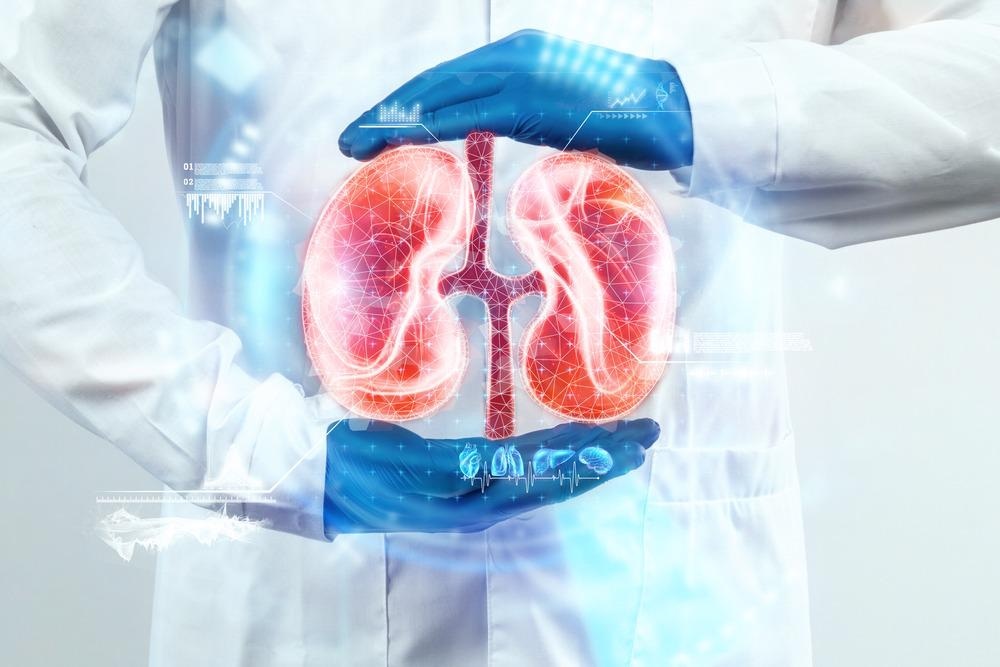Various microscopy-based imaging modes have been considered the cornerstone for kidney research and enabled the elucidation of the complex spatiotemporal biological phenomena. The most recent advances in these imaging modalities include intravital two-photon microscopy, first applied to the live kidney in 2002.

Image Credit: Marko Aliaksandr/Shutterstock.com
Since its inception, this technique has been widely adopted with success. A vital feature of this microscopy technique is the real-time visualization and quantification of objects and events at the subcellular level; this feature is not achievable by other means of visualization. Despite this, imaging depth continues to present a challenge.
Coupling Intravital Fluorescence Microscopy to Multiphoton Microscopy
The development of intravital imaging with multiphoton microscopy has critically impacted kidney research; it explicitly provides the opportunity to visualize the dynamic behavior of the cells and organelles in their native environment. Moreover, structure-function relationships can be deduced as a consequence of visualizing such systems. In addition to this, intravital kidney microscopy enables how cells respond to physiological intervention or in response to disease-causing agents. Overall, intravital microscopy has made essential insights into physiological and pathophysiological processes in the kidney.
Multiphoton microscopy is a form of fluorescence imaging that implements a long-wavelength pulsed excitation laser within the range of 700-1000nm. It relies on the principle that two or more low-energy photons arriving simultaneously can excite a fluorescent molecule. It offers several advantages over conventional confocal microscopy when working with intact tissues. Namely, increased depth of amazing on decreased phototoxicity. Coupling intravital imaging with multiphoton microscopy serves as a powerful tool in preclinical research.
Multiphoton microscopy allows kidney structures such as the glomerular and peritubular vasculature, proximal and distal tubules, and the collecting duct to be visualized. In addition, multiphoton microscopy allows the precise identification of parietal cells, mesangial cells, endothelial cells, and podocytes
Depth of Imaging Possible In Intravital Kidney Microscopy
The maximum depth of intravital multiphoton imaging in the kidney is within 100μm and is equivalent to rodent kidneys' outer core tax. This presents a problem, but glomeruli lie deeper than this in most species. The reason for this limited imaging penetrance is unknown but hypothesized to be because the kidney is opaque. A more compelling reason is that the tissue itself is dense and exhibits high levels of autofluorescence. These are compounded by the light scattering effects of high blood flow.
To mitigate this challenge, several strategies have been deployed. For example, specific breeds of rats have surface glomeruli that are conveniently amenable to imaging. Another strategy is to render the kidney hydronephrotic, that is, swelling, which pushes the glomeruli to a more amenable position to imaging.
More recently, the combination of longer wavelength excitation with far-red fluorescent probes coupled with highly sensitive detectors has increased the depth of imaging achievable with multiphoton imaging. In addition, this method minimizes the level of background autofluorescence at longer excitation wavelengths, which subsequently improves the signal-to-noise ratio.
Despite these attempts to improve imaging depth, it remains a problem in intravital kidney microscopy.
Genetically Encoded Fluorescent Sensors
Genetically encoded calcium indicators have changed how intravital microscopy is performed and enabled a detailed study of a second messenger, calmodulin, in intact kidneys. They have been used to investigate calcium signaling in all major kidney cell types.
For example, the glomerulus has been found to increase in calcium (specifically in the podocytes) in response to angiotensin II, and this is particularly meaningful in disease cases. Tubular expression in rocks has demonstrated that the proximal tubule slows down spontaneous transients in calcium.
Other than calcium, genetically encoded sensors have been used as critical readouts of cellular function in vivo. For example, a mitochondrial redox-sensitive probe demonstrated evidence of augmented reactive oxygen species in the glomeruli and tubules of diabetic mice. Finally, a fluorescence resonance energy transfer (FRET)-based sensor was used to follow changes in space on time in cellular ATP along the nephron during ischemic acute kidney injury. This was critical in the subsequent calculation of chronic damage and fibrosis risk.
Quantitative Analysis of Intravital Images
An early and persistent criticism of intravital microscopy was how qualitative images could be transferred into quantitative data, which can be subject to rigorous statistical analysis. This skepticism was related to issues such as tissue movement, laser-induced tissue artifacts, and observer bias.
However, a set of sophisticated image analysis tools have now enabled the correction of tissue movements, and the process can be at least partly automated, which reduces bias. In addition, productivity is enhanced due to the ability to generate large quantities of multidimensional imaging data as manual analysis is circumvented.
The development of intravital imaging was a turning point in kidney research. The practical hurdles that presented a barrier to the potential of this approach are increasingly becoming overcome due to advances in laser and microscope technology, fluorescent probe design, and the use of transgenic animals. In addition, machine-learning-based image analysis has now been harnessed to process large quantities of data.
Sources:
- Miller MA, Weissleder R. (2017) Imaging the pharmacology of nanomaterials by intravital microscopy: Toward understanding their biological behavior. Adv Drug Deliv Rev. doi:10.1016/j.addr.2016.05.023.
- Hato T, Winfree S, Dagher PC. (2018) Kidney Imaging: Intravital Microscopy. Methods Mol Biol. doi:10.1007/978-1-4939-7762-8_12.
- Martins JR, Haenni D, Bugarski M, et al. (2021) Intravital kidney microscopy: entering a new era. Kidney Int. doi: 10.1016/j.kint.2021.02.042.
Further Reading
Last Updated: May 4, 2022